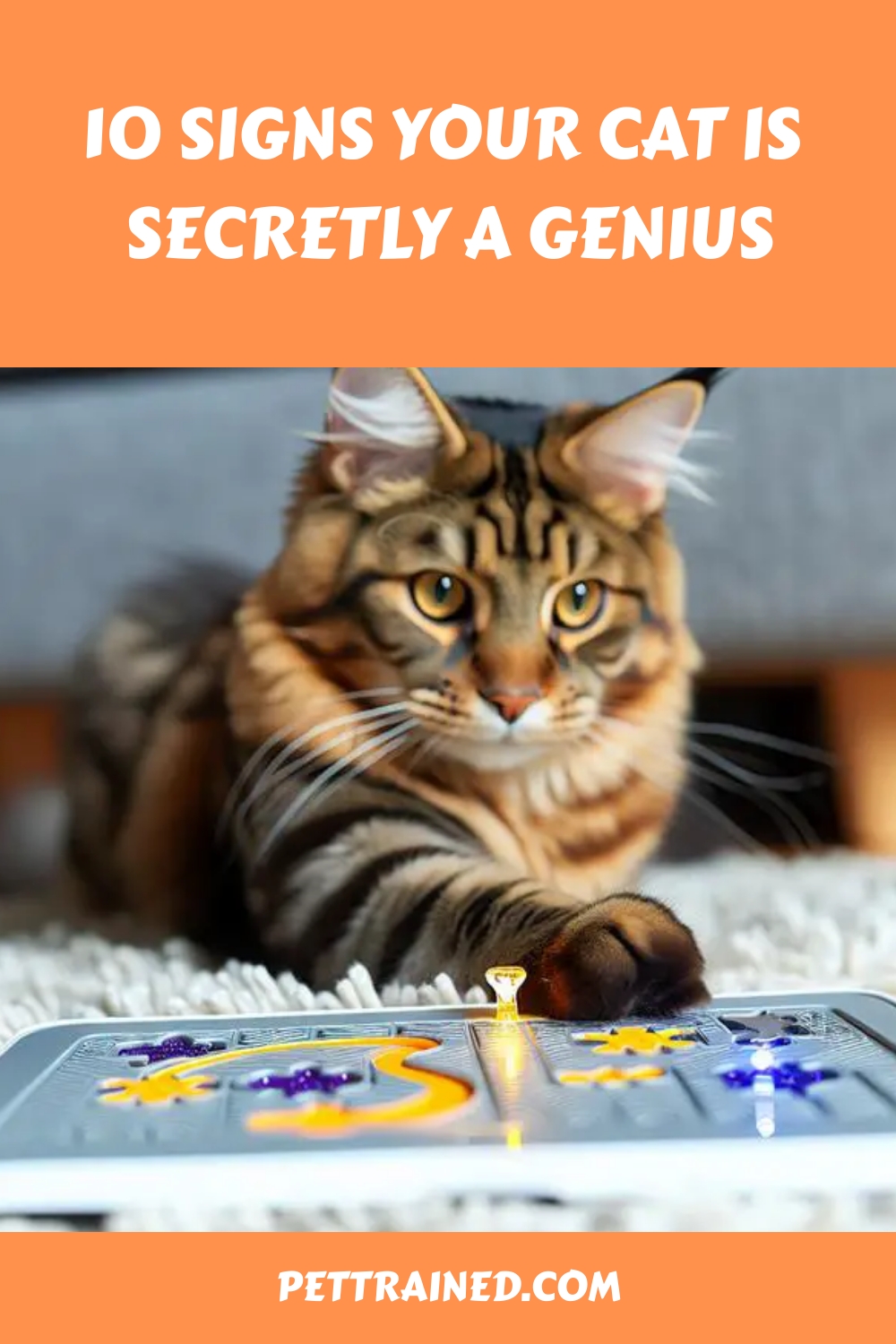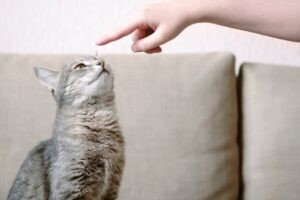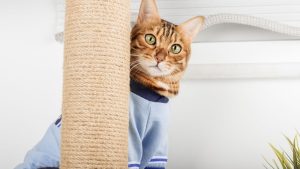You might think your cat is just being playful and mischievous, but what if the behavior indicates something deeper?
Imagine your feline solving puzzles, manipulating objects with precision, or even showing advanced social intelligence by responding to your emotions.
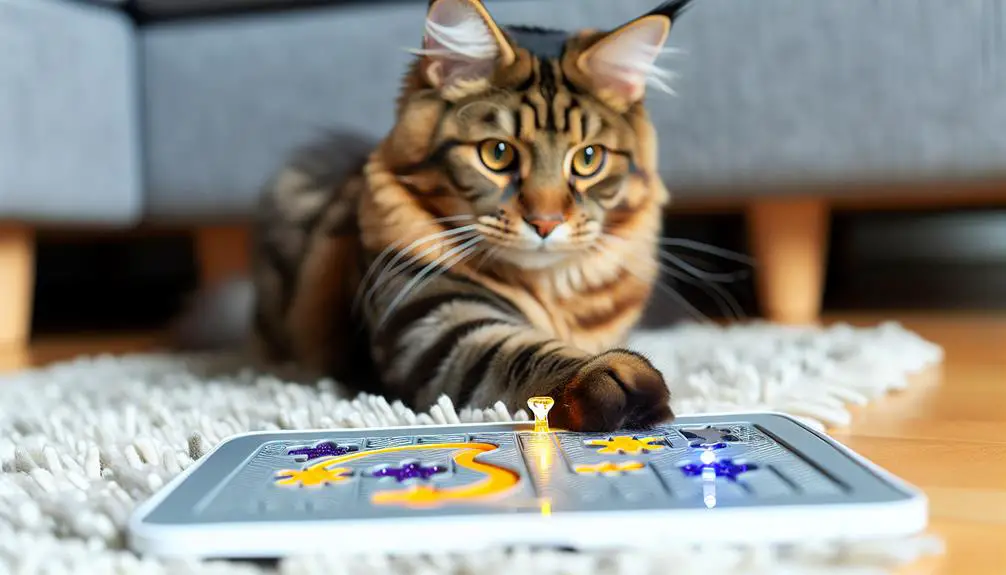
These behaviors could be signs of a hidden genius.
By observing your cat’s problem-solving skills, complex communication methods, and memory retention, you could uncover the intellectual prowess lurking beneath that furry exterior.
Ever wondered if your cat is more than just a pretty face?
Let’s explore the fascinating signs that your cat might be secretly brilliant.
This post contains affiliate links. However all the information provided on this site are my own honest opinions. See more in Disclaimer.
Table of Contents
1. Problem-Solving Skills
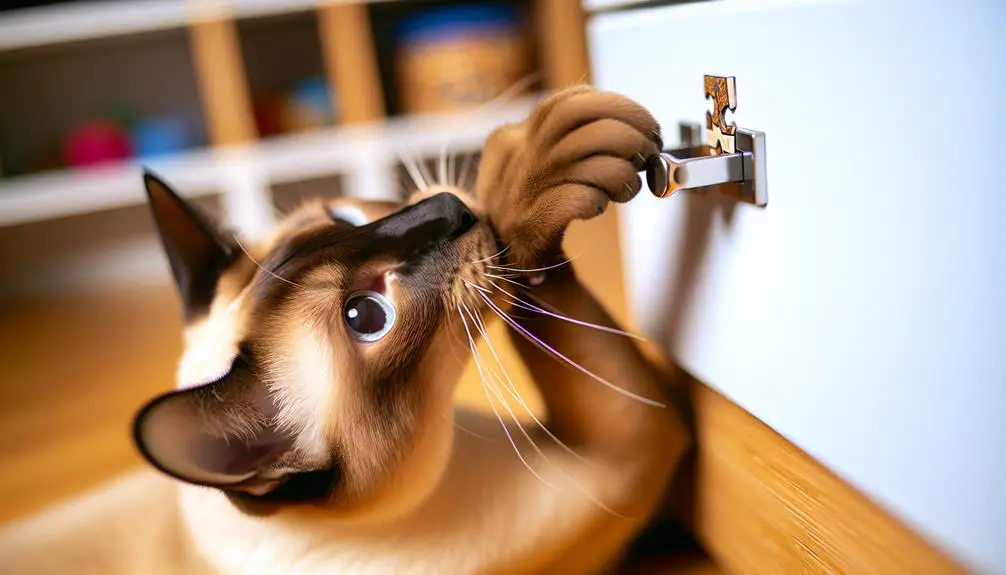
Your cat’s ability to navigate complex situations, such as opening doors or retrieving hidden objects, can be a strong indicator of advanced problem-solving skills.
Observing your feline engage in puzzle-solving and object manipulation provides critical insights into their cognitive abilities. Cats often demonstrate these skills by figuring out how to access food from intricate containers or toys designed to challenge their intellect.
Research in feline cognition has shown that cats possess a remarkable capability for understanding cause-and-effect relationships.
When your cat interacts with puzzle feeders, they’re not just playing; they’re engaging in a sophisticated mental exercise that stimulates their brain’s problem-solving regions.
The ability to manipulate objects, like using their paws to slide open cabinets or tip over containers, further underscores their dexterity and mental acuity.
Moreover, studies suggest that cats who regularly engage in activities requiring puzzle solving and object manipulation tend to show higher levels of curiosity and adaptability. These behaviors aren’t merely instinctual but are often a sign of higher cognitive functioning.
Hence, encouraging these types of interactions through appropriate toys and challenges can considerably enhance your cat’s mental stimulation, promoting their overall well-being.
2. Advanced Play Techniques

Building on their problem-solving prowess, advanced play techniques can further reveal a cat’s intellectual sophistication.
One key indicator is their ability to engage with puzzle toys.
These toys are designed to challenge your cat’s cognitive abilities by requiring them to manipulate components to access a reward, such as treats. Observing how swiftly and effectively your cat solves these puzzles offers insight into their problem-solving skills and adaptability.
Intricate games also serve as proof of a cat’s advanced cognitive functions.
Games that involve multiple steps, like fetching specific objects or maneuvering through complex mazes, demonstrate your cat’s capacity for strategic thinking and memory retention.
For instance, a cat that remembers the sequence of actions needed to release a hidden toy exhibits not just intelligence but also a high level of cognitive flexibility.
Moreover, cats that engage in these advanced play techniques often show signs of enhanced neurological health.
Studies indicate that mental stimulation through intricate games and puzzle toys can mitigate cognitive decline in aging cats, much like brain exercises do for humans.
Incorporating these advanced play activities into your cat’s routine not only showcases their genius but also promotes long-term mental well-being.
3. Complex Communication

Complex communication in cats often manifests through nuanced vocalizations, body language, and interactive behaviors that suggest a sophisticated understanding of their environment and human companions.
Evidence shows that cats use a range of vocal variations to convey different messages. For instance, a high-pitched meow might indicate excitement, while a low-pitched growl can signal discomfort or aggression.
Moreover, body language in cats is an important indicator of their communicative prowess.
A cat’s tail position, ear orientation, and even the dilation of their pupils can provide insights into their emotional state and intentions. When your cat’s tail is upright and quivering, it often signifies affection and contentment.
Here are some specific behaviors that demonstrate complex communication:
- Chirping and Trilling: These sounds are often reserved for interactions with humans, indicating a cat’s desire for attention or play.
- Slow Blinking: A slow blink from your cat is a sign of trust and affection, often referred to as a “cat kiss.”
- Purring Variations: Different purrs can signify contentment, pain, or even a request for food.
- Tail Flicking: Rapid tail flicking can indicate irritation or agitation, while a gentle sway might show curiosity.
Understanding these behaviors can greatly enhance your relationship with your feline friend.
4. Memory Retention
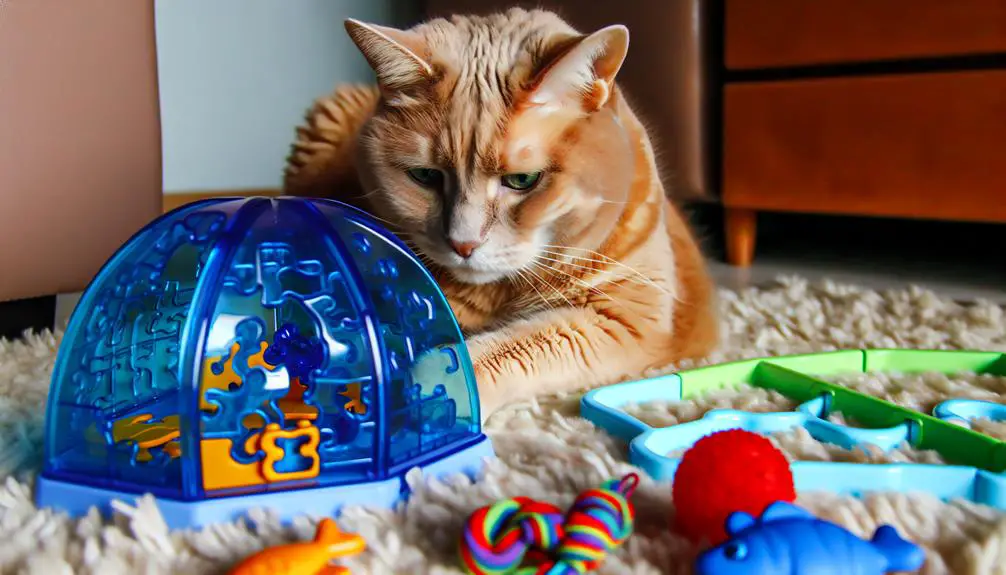
Cats exhibit remarkable memory retention, often recalling people, places, and experiences with a level of detail that underscores their cognitive abilities.
Studies have shown that felines possess both short-term and long-term memory capabilities.
Their capacity for object permanence allows them to understand that objects or individuals continue to exist even when out of sight, which is an essential cognitive skill typically demonstrated by intelligent species.
Moreover, cats excel in associative memory, which enables them to link specific experiences or stimuli with resulting outcomes.
For instance, your cat may associate the sound of a can opener with feeding time, demonstrating a learned behavior through memory.
This associative learning isn’t merely a conditioned reflex but a sign of sophisticated cognitive processing.
Research indicates that cats can remember events or interactions for extended periods, sometimes months or even years.
This memory retention is fundamental for their survival, helping them navigate their environment, recognize familiar individuals, and avoid previously encountered dangers.
Their ability to recall and process information from past experiences showcases their intelligence and adaptability, making them astoundingly perceptive companions.
Understanding these memory capabilities can deepen your appreciation for the complex cognitive world your cat inhabits.
5. Self-Awareness
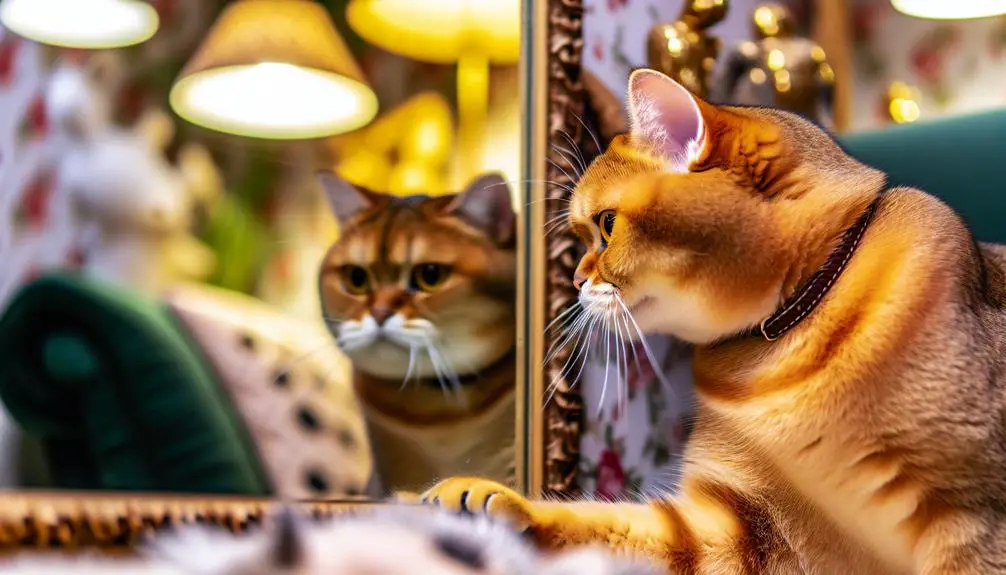
Self-awareness in felines is a debated topic among researchers, but emerging studies suggest that they may exhibit behaviors indicative of a conscious self-perception.
Evidence-based research has observed certain behaviors in cats that hint at this advanced cognitive ability. One such behavior is mirror recognition. Unlike many animals, some cats have shown signs of recognizing their reflection, which implies a level of self-awareness.
Additionally, cats display emotional responses that suggest they understand their own and others’ emotions.
This can be seen when they comfort their owners during times of stress or exhibit jealousy when attention is given to another pet.
Here are four key behaviors that might indicate your cat possesses self-awareness:
- Mirror Recognition: If your cat interacts with its reflection in a way that seems exploratory rather than aggressive, it might recognize itself.
- Emotional Responses: Notice if your cat reacts to your moods, offering comfort or showing distress during your emotional highs and lows.
- Problem-Solving: Cats often demonstrate an ability to solve complex problems, which suggests a higher level of cognitive functioning.
- Unique Preferences: Cats showing consistent preferences for certain toys or routines may indicate an awareness of their own likes and dislikes.
6. Tool Usage
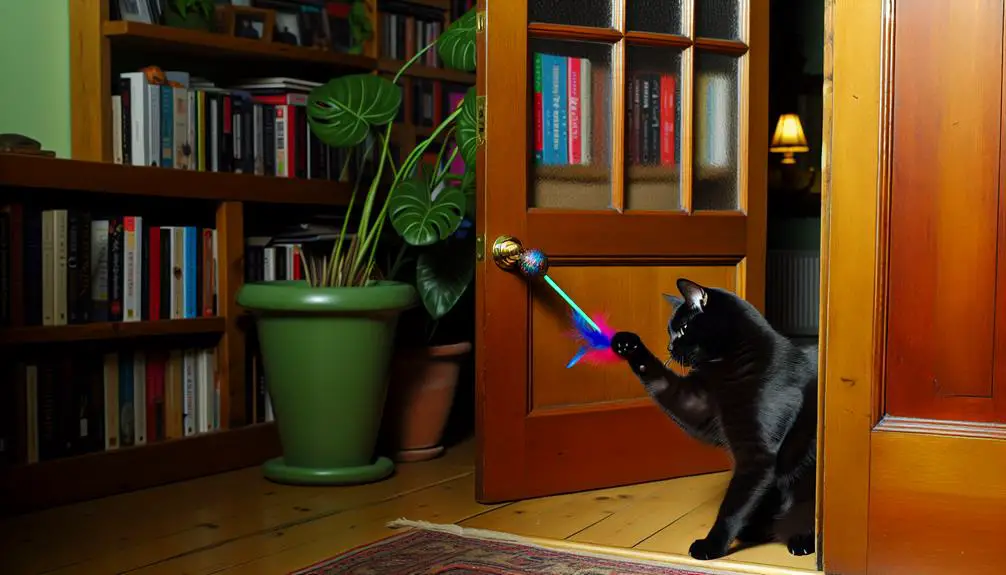
In recent studies, researchers have observed that some felines exhibit rudimentary tool usage, a behavior often associated with advanced cognitive abilities.
Cats have been noted to manipulate objects in their environment to achieve specific goals, such as gaining access to food or finding their way around obstacles.
One compelling example is door opening. Certain cats have learned to use their paws to manipulate door handles, demonstrating an understanding of cause and effect. This ability requires spatial awareness and problem-solving skills, indicating a higher level of cognitive function.
Another area where tool usage becomes evident is food puzzles. Cats that successfully interact with these puzzles must figure out how to manipulate the components to release treats.
This involves not only memory and dexterity but also a degree of forward planning. The complexity of the food puzzles can vary, but even simple ones require a cat to employ a series of actions in a specific sequence, showcasing their intellectual capabilities.
While these behaviors are not universally present in all cats, they suggest that those who do exhibit them possess cognitive abilities that go beyond basic instincts. Such tool usage highlights the potential for higher-order thinking in felines, making them more than just household pets.
7. Observational Learning
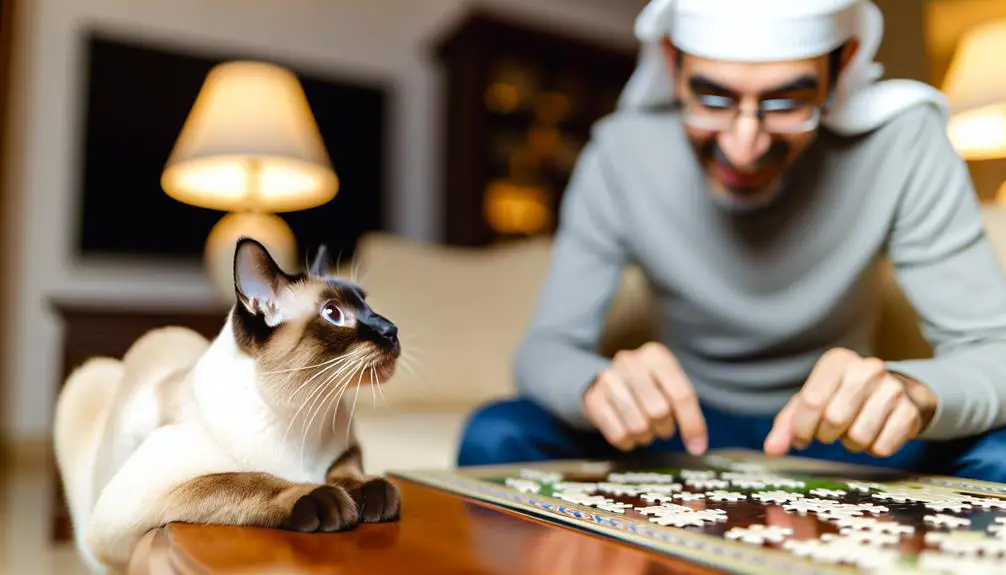
Observational learning, where felines acquire new behaviors by watching others, underscores their capacity for cognitive sophistication.
This form of learning is mediated by mirror neurons, specialized brain cells that activate when an animal performs an action or observes another performing the same action.
These neurons facilitate your cat’s ability to mimic behavior seen in humans or other animals.
Here’s how you can identify this genius trait in your cat:
- Imitating Human Actions: If your cat observes you opening a door and then attempts to do the same, it’s exhibiting observational learning.
- Learning from Other Pets: When your cat adopts new tricks or habits after watching another pet, it’s a clear sign of mimic behavior.
- Puzzle Solving: Cats that figure out how to solve a puzzle toy after observing you demonstrate their advanced cognitive abilities.
- Copying Feeding Techniques: If your cat watches how you handle a feeding mechanism and replicates it, it’s using learned behavior to access food.
These behaviors highlight how observational learning, driven by the functionality of mirror neurons, showcases your cat’s ability to process and replicate complex actions, reflecting a high level of cognitive sophistication.
8. Social Intelligence

Beyond their ability to learn through observation, cats also exhibit remarkable social intelligence, enabling them to navigate complex social structures and interact effectively with both humans and other animals.
Cats demonstrate emotional empathy by responding to the emotional states of their human companions.
For instance, they may purr and knead when you’re stressed, providing comfort and emotional support.
This behavior indicates a sophisticated understanding of your emotional state, a hallmark of advanced social intelligence.
Furthermore, cats adeptly understand and manipulate social hierarchy. In multi-cat households, you’ll notice clear dominance-subordination relationships, where each cat understands its rank and behaves accordingly.
This keen awareness of social hierarchy helps them avoid conflicts and maintain a stable social environment.
They also extend this understanding to their interactions with humans, often recognizing who in the household is more likely to feed or play with them and adjusting their behavior to gain favor.
Studies have shown that cats can remember interactions with specific individuals and adjust their future behavior based on these experiences.
This ability to recall past social interactions and modify behavior accordingly further underscores their sophisticated social intelligence.
9. Spatial Awareness
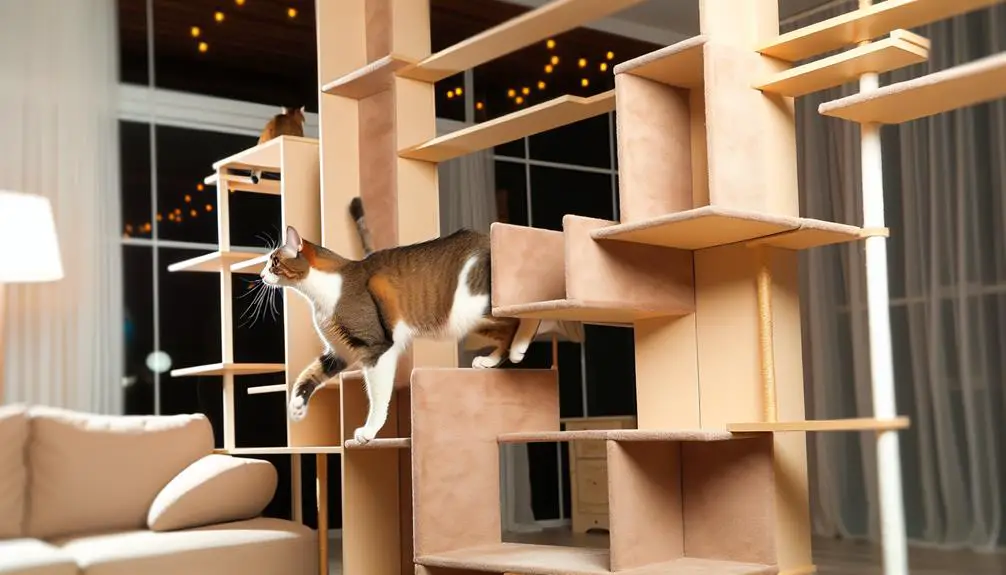
Cats exhibit an extraordinary level of spatial awareness, allowing them to navigate their environment with remarkable precision and agility.
This keen sense of spatial perception is evident in various behaviors and abilities that highlight their cognitive prowess.
Cats possess advanced navigational skills, enabling them to remember hidden pathways and access points within their territory.
Here are four ways to recognize your cat’s spatial awareness:
- Obstacle Avoidance: Cats can effortlessly maneuver around objects, even in the dark. They rely on their whiskers and keen eyesight to gauge distances and avoid collisions.
- High Jumps and Landings: Their ability to jump to high places and land gracefully showcases their understanding of spatial relationships and body mechanics.
- Memory of Hidden Pathways: Cats remember intricate details about their environment, such as hidden pathways or shortcuts, which they use to move stealthily and efficiently.
- Squeezing through Tight Spaces: Their flexible bodies and acute awareness of space allow them to judge whether they can fit through narrow openings, often surprising their owners with their contortionist abilities.
These behaviors indicate a level of spatial intelligence that not only safeguards their survival but also underscores their status as master navigators in their domain.
10. Curiosity and Exploration

While their spatial awareness is impressive, a cat’s insatiable curiosity and penchant for exploration further illustrate their cognitive sophistication.
Cats are known for their remarkable climbing prowess, a skill that not only showcases their physical agility but also their problem-solving abilities. When a cat navigates vertical spaces or perches on high shelves, it’s demonstrating complex spatial reasoning and a keen understanding of its environment.
In addition to climbing, cats exhibit a remarkable ability to find and utilize hiding spots.
These behaviors aren’t merely instinctual but also indicate advanced cognitive processes.
By seeking out hidden or enclosed spaces, cats engage in strategic thinking and risk assessment, which are hallmarks of intelligent behavior.
Research supports the notion that a cat’s exploratory habits are linked to their cognitive capabilities.
Studies have shown that cats who actively engage in exploration tend to have higher levels of environmental enrichment, leading to enhanced mental stimulation and overall well-being.
